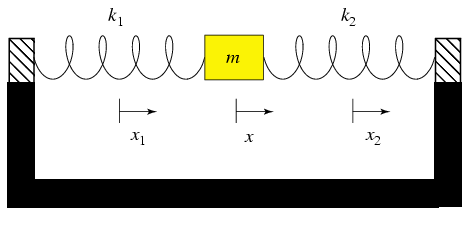k1 Con si der the sy stem shown in the diagram, which consi st s of two springs with constants k and k2 and a mass m. oscillation fre quency v of the mass? If all surfaces are frictionless, what is the
Simple harmonic motion
Simple harmonic motion is a type of periodic motion in which an object undergoes oscillatory motion. The restoring force exerted by the object exhibiting SHM is proportional to the displacement from the equilibrium position. The force is directed towards the mean position. We see many examples of SHM around us, common ones are the motion of a pendulum, spring and vibration of strings in musical instruments, and so on.
Simple Pendulum
A simple pendulum comprises a heavy mass (called bob) attached to one end of the weightless and flexible string.
Oscillation
In Physics, oscillation means a repetitive motion that happens in a variation with respect to time. There is usually a central value, where the object would be at rest. Additionally, there are two or more positions between which the repetitive motion takes place. In mathematics, oscillations can also be described as vibrations. The most common examples of oscillation that is seen in daily lives include the alternating current (AC) or the motion of a moving pendulum.

If a mass m is attached to a spring with spring constant k and is displaced from the equilibrium position, a restoring elastic force opposite to the displacement is exerted by the spring.
The equation of motion for such a mass on a spring, is given by using Hooke's law-

During the oscillation, one spring is stretched and other is compressed and vice-versa.
Let x be the displacement of mass m from its equilibrium position, and this is also the compression and expansion in the springs, .
The restoring force developed in the two springs is
Since both these forces acts on the mass m in the same direction (towards left in our case of motion of mass). Therefore-
or
Thus the force constant of the system is ()
Since angular frequency is given by:
Step by step
Solved in 3 steps with 1 images









